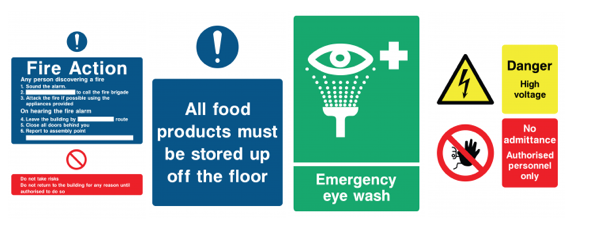Why Safety Signs Are Important
Ensuring the health and safety of your employees within the workplace is not just the right thing to do, it’s understandably a legal requirement.
In fact, The Health and Safety (Safety Signs and Signals) Regulations 1996 mandate, stipulates that safety signage is required where there may be significant risks to the health and safety of employees and others.
As you could imagine, safety signs such as construction signage, for instance, are also required to be clear, legible, and placed prominently.
Know Your Safety Signs
Safety signs come in many forms such as;
Access Prohibition Signs clearly communicate prohibited areas such as No Entry Signs, No Access Signs, and even No Parking Signs.
Dangerous Substances Signs, also known as Harmful Substances Signs outline the risks associated with a range of dangerous substances. Signs can include Coshh signs, including Coshh Warning signs, and Flammable Signs.
Disability Discrimination Act Signs, these signs are specifically designed to help organisations comply with the Disability Discrimination Act (DDA). They can include disabled ramp access signs, including disabled parking and more.
Emergency Exit Signs clearly highlight fire exits with exit signage, along with assembly points too. Popular emergency exit signs include fire exit signs, push bar to open signs, and many more.
Fire Extinguisher Signage, can play a pivotal role in surviving a fire emergency, while exit signs will help guide the way, exit signs are of course of equal importance.
First Aid Signs play a key role in terms of directing people where to find first aid or medical kits. For instance, a first aid sign could be a first aid station sign, emergency eyewash sign, or an emergency stop sign.
Food Hygiene Signs for kitchen areas on your premises can help to improve the levels of food hygiene, which of course, is imperative where food is prepared or handled.
Remember, if you are a UK business serving or preparing food then you’ll be given a food hygiene rating by the Foods Standards Agency.
General Prohibition Signage, also known as no signs are prohibiting notices for acts or behaviours which may be a health and safety risk. These signs are typically all red to further highlight the risk of potential harm.
Most prohibition safety signs are often accompanied by the instruction “No” or “Do Not”, for instance, no food or drink signs, or no mobile phone sign.
Mandatory Machinery Signage, also known as mandatory equipment signs outline specific actions that must be followed when operating machinery or equipment. For example, in a warehouse or even a construction site setting mandatory signage such as sound horn drive slowly, and a stack correctly sign may be appropriate to display.
Mandatory PPE Signs, these signs act as an instruction as to when Personal Protective Equipment (PPE) must be worn for health and safety.
Our PPE safety signs can help your organisation comply with the (Safety Signs and Signals) Regulations 1996. In the current climate with a global pandemic, we also have a range of Coronavirus safety signs too.

